(Press-News.org) A new study reveals nuanced findings on the neuropsychiatric risks of prenatal cannabis exposure. The research found a slight increase in the risk of ADHD and a heightened vulnerability to cannabis use in offspring. These results highlight the need for continued caution and further investigation into the long-term effects of cannabis use during pregnancy.
A new study led by Prof. Ilan Matok and Hely Bassalov PharmD from the Department of Clinical Pharmacy at the School of Pharmacy in the Faculty of Medicine at Hebrew University in collaboration with Prof. Omer Bonne and Dr. Noa Yakirevich-Amir from the Department of Psychiatry at the Hadassah Medical Center, sheds light on the potential long-term neuropsychiatric risks associated with prenatal cannabis exposure. As the global trend toward cannabis legalization continues, the prevalence of cannabis use among pregnant women is on the rise, raising concerns about its impact on fetal development.
The study, a comprehensive systematic review and meta-analysis involving over 500,000 participants from observational studies, aimed to assess the potential risks posed by prenatal exposure to Δ9-tetrahydrocannabinol (THC), the primary psychoactive compound in cannabis. THC is known to cross the placenta, potentially affecting the developing fetal brain.
The results of the study provide a nuanced understanding of the potential risks. Most notably, the findings indicate no significant association between prenatal cannabis exposure and an increased risk of autism spectrum disorder (ASD), psychotic symptoms, anxiety, or depression in offspring. However, the study did identify a slight increase in the risk of attention-deficit/hyperactivity disorder (ADHD) and a heightened vulnerability to cannabis consumption in children exposed to cannabis in utero.
“These findings suggest that while prenatal cannabis exposure does not appear to significantly increase the risk for many neuropsychiatric disorders, there is still a mild increase in the risk for ADHD and a greater likelihood of cannabis use in the offspring,” said Prof. Matok. “This calls for cautious interpretation, as it does not confirm the safety of cannabis consumption during pregnancy.”
The study emphasizes the importance of continued research in this area, especially given that most of the studies on the subject were conducted between the 1980s and early 2000s, when cannabis was characterized by considerably lower Δ9-THC content than currently used compounds. Thus, findings presented in the current study may potentially underestimate the impact of contemporary prenatal cannabis exposure on the long-term neuropsychiatric outcomes.
“While our study provides important insights, it is crucial to recognize that these results are not definitive. Pregnant women should be aware of the potential risks, and healthcare providers should continue to advise caution when it comes to cannabis use during pregnancy,” Prof. Matok added.
This research marks a significant step forward in understanding the complex relationship between prenatal cannabis exposure and neuropsychiatric outcomes in children. As the legal landscape surrounding cannabis continues to evolve, studies like this will be essential in guiding public health recommendations and ensuring the well-being of future generations.
Methodology: The methodology of this systematic review and meta-analysis involved analyzing 18 observational studies, with 17 included in the quantitative analysis, covering 534,445 participants. The review compared neuropsychiatric outcomes in offspring exposed to cannabis prenatally to those unexposed, focusing on conditions such as ADHD, ASD, anxiety, depression, psychotic disorders, and substance use. The studies spanned from the 1980s to early 2000s, reflecting older cannabis potencies, and included data from multiple countries, with the literature search completed by January 2024.
END
Minimal ADHD risk from prenatal cannabis use new study reveals
2024-09-03
ELSE PRESS RELEASES FROM THIS DATE:
Study suggests gun-free zones do not attract mass shootings
2024-09-03
Gun-free zones have often been blamed for making schools, malls and other public areas more attractive to shooters; however, there have been no quantitative studies examining those claims. Now, in a first of its kind study published in The Lancet Regional Health Americas, researchers at UC Davis Health and other institutions have shown that gun-free zones may, in fact, reduce the risk of mass shootings.
"Our most significant finding is that gun-free zones don't attract active shooters,” said the study’s first author, Paul Reeping, ...
Mathematicians model a puzzling breakdown in cooperative behaviour
2024-09-03
Darwin was puzzled by cooperation in nature—it ran directly against natural selection and the notion of survival of the fittest. But over the past decades, evolutionary mathematicians have used game theory to better understand why mutual cooperation persists when evolution should favour self-serving cheaters.
At a basic level, cooperation flourishes when the costs to cooperation are low or the benefits large. When cooperation becomes too costly, it disappears—at least in the realm of pure mathematics. ...
Kessler Foundation scientists publish protocol for combining aerobic exercise and cognitive rehabilitation in multiple sclerosis
2024-09-03
East Hanover, NJ – September 3, 2024 – Researchers at Kessler Foundation have published a new clinical protocol examining the combination of aerobic exercise and cognitive rehabilitation to improve learning and memory in individuals with multiple sclerosis (MS) who have mobility disability. The article, “Rationale and methodology for examining the combination of aerobic exercise and cognitive rehabilitation on new learning and memory in persons with multiple sclerosis and mobility disability: Protocol for a randomized controlled trial,” was published online and will appear in print in Contemporary Clinical Trials, ...
New hope for progressive supranuclear palsy with innovative trial
2024-09-03
$75 million NIH grant could lead to the first effective drugs for a condition with few treatment options
A clinical trial that will test three drugs concurrently, and could include more, represents new hope for patients with progressive supranuclear palsy (PSP), an incurable neurodegenerative disorder that usually kills within seven years after symptoms start.
Researchers hope the trial, which will be led by UC San Francisco and conducted at up to 50 sites nationwide, will lead to the development of new therapies. There are currently no drugs to stall the disease’s deadly progression.
The ...
Mass General Brigham Gene and Cell Therapy Institute launches RNA Therapeutics Core
2024-09-03
The Mass General Brigham Gene and Cell Therapy Institute (GCTI) today announced it has launched the RNA Therapeutics Core, a first-of-its-kind, state-of-the-art facility and resource to advance the use of RNA technologies within and beyond the Mass General Brigham research ecosystem. This new Core is dedicated to accelerating the exploration of novel therapeutic targets to effectively translate RNA-based medicines into clinical practice by leveraging advanced RNA vectors and delivery systems.
Until now, a Core of this kind has not existed within an academic setting. With this launch, the RNA Therapeutics Core enables ...
Dangerous airborne fungus boosted by California droughts
2024-09-03
Valley fever is an emerging fungal disease in the western United States that most often causes flu-like symptoms, but can also cause dangerous or even deadly complications. By analyzing data on reported cases of Valley fever in California, which have increased dramatically over the last two decades, researchers from University of California San Diego and University of California, Berkeley, have identified seasonal patterns that could help individuals and public health officials better prepare for future surges in Valley fever cases. The findings also have important implications for how the changing climate can exacerbate the threat of infectious diseases. The findings are published in The ...
$1.8 million NIH grant to FAU engineering fuels quest to decode human evolution
2024-09-03
Natural selection is an important evolutionary force that enables humans to adapt to new environments and fight disease-causing pathogens. However, the unique footprints of natural selection in our genome can be buried beneath those left by other evolutionary forces. Thus, by leveraging information about multiple evolutionary forces, researchers can identify signatures of natural selection in the human genome, and ultimately determine its role in human adaptation and disease.
Low-cost DNA sequencing has ...
Communication helps parent relationships with new college students but has limits
2024-09-03
PULLMAN, Wash. -- When young adults first go off to college, more communication with parents generally leads to better relationships, but parents should avoid always initiating it, according to a study led by Washington State University researchers.
In a paper published in the journal Emerging Adulthood, WSU Assistant Professor Jennifer Duckworth and co-authors found that phone, text, video or in-person communication made first-year students feel better about the relationship with their parents. Students also felt better about the relationship when parents offered support or advice, and when they discussed important topics, such as studying and friendships. However, researchers found ...
Natural selection may create inter-species exploitation
2024-09-03
A modeling study suggests that one-sided interspecies cooperation can spontaneously emerge and persist over time, despite only one species benefitting. Evolutionary game theory, and the prisoner’s dilemma in particular, are often used to model the evolution of cooperation within a single species. In the prisoner’s dilemma, both parties benefit by cooperating, but the greatest benefit is earned by a defector who plays with a cooperator. The temptation to cheat tends to push players towards defection, ...
Targeted cancer therapies: Getting radioactive atoms to accumulate in tumors
2024-09-03
Prostate cancer is the second most common cancer among men worldwide, following lung cancer. In the United States alone, nearly 300,000 new cases are diagnosed annually. While reducing testosterone and other male hormones can be an effective treatment for prostate cancer, this approach becomes ineffective once the disease progresses to metastatic castration-resistant prostate cancer (mCRPC). At this stage, the cancer advances quickly and becomes resistant to conventional hormonal therapies and chemotherapy.
A clever strategy for fighting mCRPC is to exploit the ...




